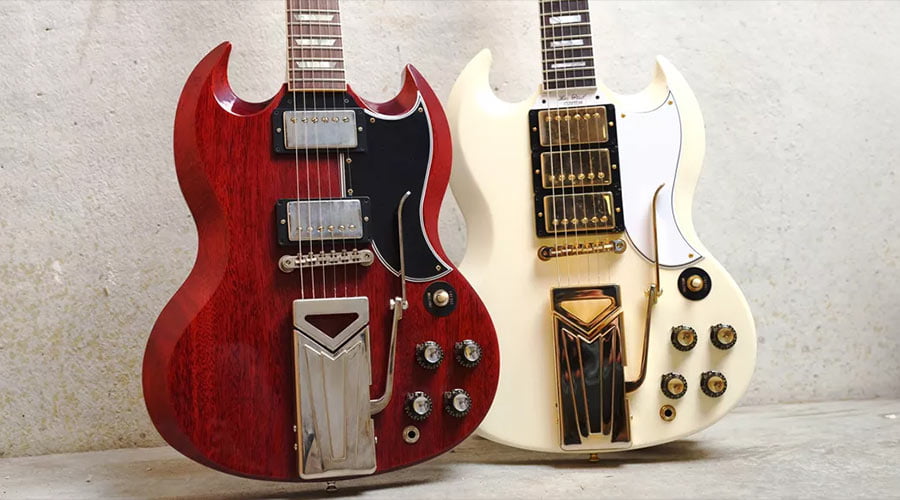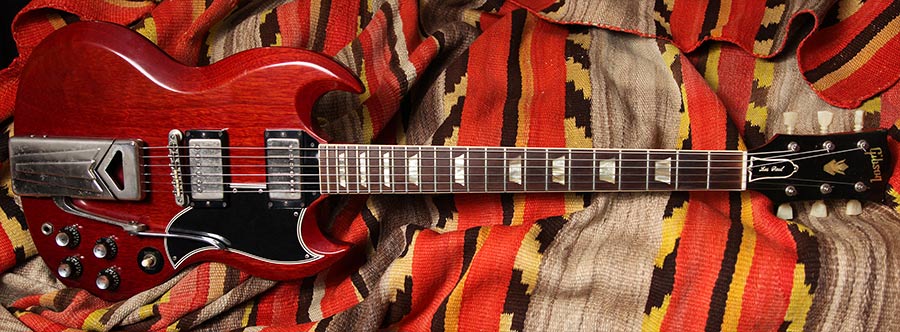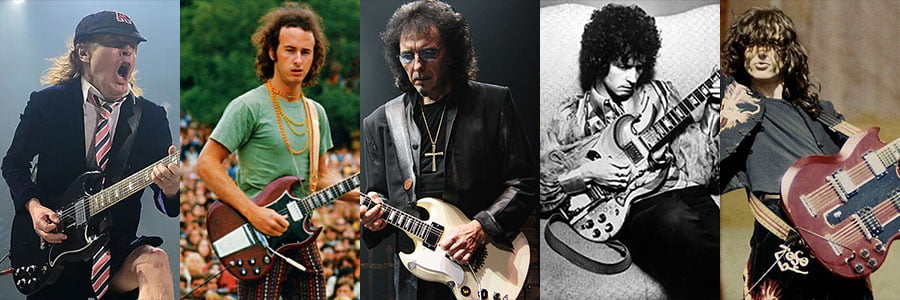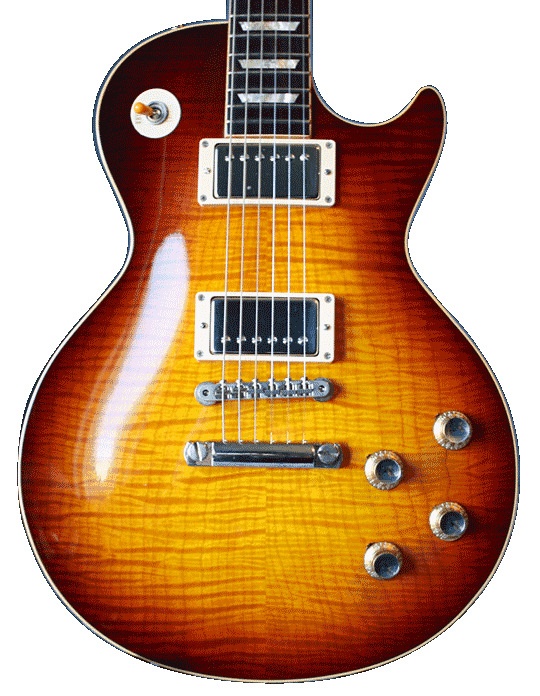
How well do you know your Gibson guitars?
Do you know that Gibson’s first solidbody electric guitar was the Les Paul? Yeah, I reckon you probably did. But did you know the year that it was first released was 1952? Hats off to you if you did. What about the ES-335? Here is a clue: it wasn’t November 5th, 1955 when it was announced. No, that would be too early (it was 1958).
Ok, so what about their biggest selling model? It’s got to be the Les Paul, surely? Well no, believe it or not, the biggest-selling Gibson guitar is the humble SG.
The guitar that Les Paul himself said was likely to kill someone with its sharp horns has gone on to become the biggest-selling model in the history of Gibson and, has been in continuous production since 1961.
Despite its success, it had an unusual start in life, but it has since gone on to become one of the most recognizable symbols of rock music. In this post, I will be taking a look at the story of the SG guitar.
History of The SG Guitar
By the start of the 1960s, the popularity of Gibson’s flagship solidbody was on the wane. Sales of the Les Paul had started to fall, and despite the introduction of the now revered sunburst models from 1958-1960, they were not shifting as much as the company had hoped. Gibson decided that a radical rethink was required.
Just as the Telecaster was the catalyst for the Les Paul, so it was Fender again that lit a fire under Ted McCarty and co. The introduction of the Stratocaster in 1954 had been a big hit for Leo Fender and by the end of the decade, many famous players could be seen with them. As before, Gibson was paying attention and they started looking for a double-cut model of their own. They didn’t have to look too far for inspiration. In 1958 Gibson had released a pair of double cutaway models: the ES-335 and the Les Paul Junior.
Design & Construction
With this in mind, they set about designing an updated Les Paul. Gone was the maple cap, this new guitar was to be a single piece of mahogany, considerably thinner than its predecessor and, of course with twin cutaways. The body itself was contoured around the edges with two distinctive beveled horns. The neck joined the body at the 22nd fret, thus giving the player unfettered access to the entire, rosewood fingerboard.
The pickups were the same, twin PAF humbuckers as the Les Paul, with the tone and volume pots hidden in a cavity in the back of the guitar. The only difference was the location of the pickup selector switch which had been moved from the upper bout of the instrument to above the volume knobs. The output jack was also moved, it was now located on the face of the guitar with the rest of it being in the same back cavity.
To compete with the Stratocaster a new sideways vibrola system was added to the guitar. This involved a lever being pressed from the side that would engage 2 springs that were attached to a mechanism that anchored the strings. Despite being a very attractive addition to the guitar, the system functioned poorly, with the strings failing to return to pitch. Many players simply opted to fold the arm down and ignore the unit.
The SG Standard was finished in the famous Gibson Cherry Red finish and featured a bound fretboard with trapezoid inlays. A black pickguard and a crown inlay on the headstock were the finishing touches to what was an already striking instrument.
When it was first released at a cost of $295 in 1961, it proved popular amongst hobbyists and musicians alike, but the model has some initial teething problems. As well as the aforementioned vibrato system the neck joint was notoriously weak. Due to neck joining at the 22nd fret and the position of the neck pickup, there wasn’t a lot of wood in-between to provide support and so the early SGs were prone to neck breaks.
This design flaw was gradually improved upon and by 1966 a visible step between the body and the neck heel at the back of the guitar provided the required strength. Also by 1966, the larger “Batwing” pickguard was added, as well as being a striking optical change it is an ideal way to date a 60’s SG without the use of a serial number. [2]
Despite the possible neck weakness, the period from 1961-1966 is widely regarded as the best years for the Gibson SG. These are now the most desirable guitars and the most expensive.
Les Paul or SG?
The Gibson Les Paul Standard hit the shelves in 1961, no that is not a typo the Gibson Les Paul Standard! So, what’s the deal?
As with all things Gibson there are conflicting stories. Les Paul and Gibson had entered into a working relationship with each other in 1952, this is a fact. So, when the Les Paul model was discontinued in 1960 Les was still under contract until 1962, this meant when the first SGs went into production in late 1960, his name was put on them. But by 1963 all mention of him was removed and the guitar was simply known as the Gibson SG, or Solid Guitar (not Standard Guitar!).
What happened? Well according to Gibson, by 1963 the name Les Paul simply didn’t carry the weight that it once had. His glory days were behind him, and it was purely a commercial decision at this point not to renew his contract. According to Les he flat-out did not like the guitar.
“The first (SG/Les Paul) I saw was in a music store…and I didn’t like the shape – a guy could kill himself on those sharp horns. It was too thin, and they had moved the front pickup away from the fingerboard so they could fit my name in there. The neck was too skinny and I didn’t like the way it joined the body; there wasn’t enough wood, at least in my opinion. So I called Gibson and asked them to take my name off the thing. It wasn’t my design.”[3]
Whilst it would be unfair to question the veracity of this statement, another factor was also at play. Around this time Les was going through a divorce and any new endorsements he signed would have had to be split with Mary Ford. So even if Les did like the new design he was unlikely to want to sign another 10-year deal at a reduced rate. Whatever the reason(s) in 1963 there was no more mention of Les Paul, it was now and forever more the SG.

Characteristics
What makes an SG an SG? What is an SG good for? Is it even a good guitar at all? Well, all guitars have their own character, and the SG is no different.
The SG has its own sound. It can be said that it barks while the Les Paul sings. It has a pronounced growl that has made it the ideal rock guitar. Of course, the powerful attack of the twin humbuckers has a lot to do with this, but the thinner body means it doesn’t quite have the sustain of its predecessor but it more than makes up for it in aggression.
So, what kind of music is the SG suited for? Barring the funkiest single coil licks, the SG can handle just about whatever you throw at it. Blues, rock, jazz, metal, punk even gospel, you name it, and there’s a good chance you’ll find someone in each of these genres playing one. They are excellent instruments and extremely versatile. Obviously, those horns give the guitar an aggressive look, but at 62 years young, the SG is no longer the cheeky upstart, she’s a classy lady. You can bring her to a jazz club, or a metal night and she will be equally at home.
Another of the typical SG characteristics is neck size. As a child of the 60’s the SG is very much known for its slim neck. This is not to say it is impossible to find one with a bit more girth but on average these are a ’60s slim taper style.
Without a doubt, the biggest criticism that gets thrown at the SG is the tendency for it to be neck heavy. Because the body is light, and the neck is attached at the 22nd fret, the guitar can suffer from what is known amongst players as “neck dive”. When you let go of the neck it can “dive” or move downwards. For some it is a real problem, for others, it makes no difference. It is very much dependent on the guitar, some do it and some don’t. If this bothers you, it is easily fixed by using a wider strap preferably made of leather.
This leads us to the SG’s Achilles heel: the neck joint. As we have seen, the neck meets the body at the 22nd fret, this means that unlike the Les Paul or even a Strat, the body offers no support. Whereas with the LP the neck slots into the body giving the neck a full 7 frets worth of support, the SG has no support. This means that if you drop one, there’s a damn good chance the neck will separate from the body. You ever seen Slash pushing on the neck of his Les Paul to lower the pitch of the strings? Yeah, don’t do it on an SG, it won’t end well. You’ve been warned.
SG Models
Since the SG first appeared in 1961, there have always been several different models available. Here we take a look at a few of the modern offerings. If any of these take your fancy, they are easily available online at retailers like Sweetwater or Andertons, or even Gibson.com. As with all guitars, it is preferable to try before you buy, so go in-store if you can or at least make sure there is a return policy. All these guitars come with size 10-46 gauge strings.
Epiphone SG Standard
Epiphone offers several recreations of the Gibson SG, from the Custom Shop designed, 1961 Inspired by Gibson to the Power Players SG starter pack, there is an SG for all budgets.
So, what is the difference between the Epiphone SG and its bigger brother? Firstly, the Epiphones are made in China in the Qingdao factory, whilst this may or may not be an indicator of quality it undoubtedly allows for greater savings when it comes to labor costs.
Second, the Epiphone SG has a mahogany body, it will be a multi-piece body but so is the modern Gibson SG so that is comparable. The fretboard wood will be a rosewood substitute such as Indian Laurel or Pau Ferro. Is this any better or worse? It is debatable, it does keep costs down but it is a deviation from the Gibson SG so it must be noted.
The hardware will be Epiphone’s own brand humbuckers, although some higher-end models do come with Gibson pickups. Typically, these will lack the clarity of the Gibson pickups but when paired with a decent amplifier they are more than capable of delivering the classic SG sound.
The last big difference between Gibson and Epiphone is in the finish. A Gibson SG will always be finished with nitrocellulose and the Epiphone will be done in a polyurethane. Again, opinions vary but it has been said that being a thinner finish, nitro allows the instrument to breathe thus creating a better sound. Poly is a much thicker finish, essentially creating a plastic shell around the guitar. This is fantastic for protecting your SG, but some argue it stifles the sound somewhat. The bottom line is that it costs less to finish a guitar in polyurethane and at gig volume who hears what kind of finish the guitar has?
Expect to pay in the region of $499/£420 for an Epiphone SG Standard.
Gibson SG Special
This is your no-nonsense, entry-level Gibson rock machine. Two Gibson P-90s, 1 wrap-around bridge/tailpiece, 2 volume, and 2 tone knobs and that is about it. Unbound neck, dot-inlays, silkscreen printed Gibson logo on the headstock, and no inlay. If it’s bling and shine you are after then it’s a hard pass, but if you are someone who would prefer to let their playing do the talking then this may well be the one for you.
Everything else is the same, rosewood board, mahogany neck and body, a nitro finish, and made in the Gibson factory in Nashville.
These can be had new for $1599/£1349.
Gibson SG Standard
This is the flagship SG. Solid mahogany body, set mahogany neck, bound-rosewood fingerboard with trapezoid inlays, and a pair of humbuckers (490R & 490T) with the classic stopbar tailpiece/ABR-1 bridge combo.
It comes as standard with the larger batwing pickguard, but Gibson does offer the 61 Standard for $100 more if it’s the smaller pickguard you prefer.
Nitro finished, of course, and available in both Heritage Cherry and Ebony finishes. This guitar doesn’t really deviate much from the original SG blueprint of 60 years ago. You can get all the sounds from Angus to Clapton.
The SG Standard will cost you $1799/£1549.
Gibson SG Custom Shop 1964 SG Standard Reissue w/ Maestro Vibrola
Ok just for fun, when only the best will do then it has to be the Gibson Custom Shop.
These bad boys do not come cheap, but you will be getting the kind of instrument that you can pass down to your kids one day. 1-piece, lightweight mahogany body, hot-hide glued in bound mahogany neck, and a rosewood fingerboard. Period-correct cellulose nitrate trapezoid inlays, VOS finish, Custombucker pickups, and the more dependable Maestro Vibrola.
It is as close to picking up a box-fresh 1964 SG as it is possible to get, and it has the sound to match the price tag.
It’s going to set you back around $4699/£4049 but it’s as good as a modern SG gets.
Notable SG Players

Angus Young
Angus and the SG are pretty much the rock n roll version of Siamese twins, they are inseparable.
He got his first in 1971 and has been worshiping at the devil-horn altar ever since, and despite owning dozens since then, he still has his original. He has used Cherry Standards, Ebony Standards, and modified Customs, but whatever the color, he has always remained faithful to the SG.
As well as the iconic look of the SG and the school uniform, the twinning of the guitar with a Marshall Plexi has become the gold standard sound of rock music.
For those about to rock, we salute you!
Robbie Krieger
The Doors guitarist got his first SG in 1964, a Gibson SG special, and would go on to buy a Standard in 1968. These two guitars were used extensively on all the Doors studio recordings as well as being his main guitars whilst on tour.
Robbie is the perfect showcase for the versatility of the instrument, he was initially a classically trained, finger-style guitarist who later became influenced by the blues. He would go on to seamlessly blend his myriad of influences whilst operating within the framework of the band.
Perhaps unjustly overshadowed by the god-like presence of Jim Morrison, he remains a criminally underrated guitar player whose influence should not be underestimated. Check out his intro to Spanish Caravan or his slide playing on Moonlight Drive.
Tony Iommi
The man who is arguably responsible for creating the genre of heavy metal started as a Strat man. When the Strat broke during the sessions for Black Sabbath, he turned to a 1960s Gibson SG Special, and by the time he had finished recording the album he was an SG man.
He has had many SGs throughout his career including specials, a 3-pickup Custom, and custom builds but he is most famous for his Cherry Red, 1964 Gibson SG Special which is known as “Monkey” and his custom-built Jaydee SG known as “The Old Boy”.
Have a listen to War Pigs, Paranoid, or Iron Man for some classic SG riffing.
Eric Clapton
The original guitar god, it is hard to find a classic guitar Old Slow Hands isn’t associated with but he’s on this list for 2 reasons: 1, his fool SG looks so goddamn cool that it would be criminal to leave it off and 2, he invented the Woman Tone on it. Who can argue?
Jimmy Page
Ok so this isn’t quite the SG Standard of Angus Young or Tony Iommi but Page’s 1968 EDS-1275 double neck is an SG nonetheless.
Once Led Zeppelin had finished recording Stairway to Heaven, Page realized he would have to think a little outside of the box if he was going to be able to reproduce the song live. He turned to a 1968 Cherry Red Gibson EDS-1275. This guitar gave him 12 strings on one side and 6 on the other, this allowed Jimmy to switch as and when required.
Check out The Song Remains the Same if you want to see JP and the double neck in all its glory.
Final Thoughts on the SG Guitar
As we have seen the Gibson SG started life as a re-work of the Les Paul, but it has gone on to become a rock and roll classic in its own right.
What is it about this guitar that has made it the biggest-selling Gibson of all time? There are several reasons. First of all, there’s the price. The SG has always been the most reasonably priced of Gibson’s Big 3. The other two are the Les Paul and the ES-335. A Gibson SG standard was priced at $305 in 1966, when you compare this to the price of a 335 which was $410 in the same year you can see why people went with the SG.
The thing is the lower cost does not mean a reduction in quality; the SG is every bit as good as its more economically challenging brethren, it is just a cheaper guitar to make. The thinner body than the Les Paul (1.34 inches or 35mm) is easier to source and without the maple cap, it is less labor intensive.
This brings me to the next point, it’s light! The average weight of an SG is around 6 pounds, that’s a good 2 pounds less than your average Les Paul. Who doesn’t want a light guitar during a 4hr set? You play an SG, and you can have it strapped on all night without fear of permanent back damage.
Last, but not least is the sound. This thing rocks! It can bark, it can growl, and it’ll even sing if you know how to treat it right. It truly is an icon in every sense of the word, from the Hollywood Bowl to the Albert Hall it has graced the biggest of stages.
Share your thoughts in our forum! 💬
👉 Introduce yourself and show off your SG guitar and other gear.
Frequently Asked Questions
What does SG mean on a Gibson guitar?
SG simply means Solid Guitar.
Why are Gibson SGs so expensive?
Gibson guitars are made in the USA, which means they have higher labor costs than guitars made in places like China. They are made using nitrocellulose, which is an expensive process, requiring several coats with a long drying time. Finally, they are made to the highest standards, using the best materials and electronics. Gibson/Epiphone has SG guitars at all price points, so if it is that sound you want then don’t be put off by the higher Gibson prices, check out the Epiphone’s they have never been better than they are now.
What are Gibson SG guitars good for?
Jazz, rock, metal, pop, country, blues: the SG can hold its own in any genre of music. It is now most closely associated with rock and metal but if you want a no-nonsense guitar, that is relatively light and comes equipped with 2 humbuckers it has got to be on your list.
How to spot a fake Gibson SG?
There are a few tell-tale signs. Is the guitar finished in nitro or poly? If it’s the thicker, more plastic feeling finish it is not a Gibson. How does the Gibson logo look? Check it against a Gibson logo from a respected dealer, usually the fake logo will look off. Check the truss-rod cover, if it has 3 screws it isn’t a genuine cover and will usually be a fake. If in doubt contact Gibson, they can help verify a genuine SG from a fake guitar.
Share this post with your friends using these one-click sharing options:
👉 Click here to share on Facebook.
👉 Click here to share on X.
👉 Click here to share on LinkedIn.

Get the latest reviews, guides and videos in your inbox.